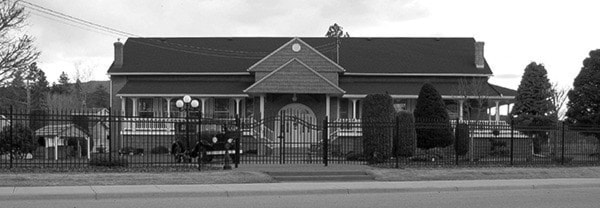Let's take a little trip, shall we?
We'll start at Slaterville, named for the Slater brothers who lived and operated a lumber mill there. The general area was originally and unofficially called "Little Scotland" for a few years but eventually there were enough Slaters living there that Slaterville seemed a logical choice. Starting there is important, as you will see.
We'll travel across the tracks, up Van Horne Street and turn left on 3rd Avenue. That's not its real name. Its real name is Watt Avenue, named for pioneer Dr. Hugh Watt of Fort Steele. He was very angry that the Canadian Pacific Railway bypassed Fort Steele and came through Cranbrook so the naming of an avenue in his honour is ironic — but that's a trip for another day.
In the original Cranbrook survey map there was neither a single street nor avenue with a number. They were all given proper names, some of them for people who lived in the area and were deemed important, i.e. Baker Street; some of them for people of noble rank, i.e. Victoria Avenue; some of them for CPR dignitaries, i.e. Van Horne; and some of them for people who may have been any of the aforementioned but of whom little is now recalled (no examples come to mind).
The original street names served the population well until 1948, when the business community and city council deemed it necessary to change the names to numbers because they apparently believed tourists were not all that bright. That is to say, not clever enough to follow directions involving streets with names instead of numbers. Sure, it works in other places but our tourists are different.
So saying, they discarded the street names and, in fact, a few years after that, changed all the house numbers on the streets by decreasing them by 100, which may or may not have helped the supposedly confused tourists but for a time certainly made the Cranbrook residents of the day appear brainless when they could neither recall the number of their street nor their house address.
Still, some names avoided the axe: Baker Street for instance (presumably because it would have become "0" Street in the new system), along with Victoria Avenue, Van Horne Street, Kootenay Street, Cranbrook Street and a few others.
It is interesting to note that a few years ago new street signs were placed throughout the Baker Hill district with both the numeric street value and the original given name. A nice touch, although they stopped at 8th (Hanson) Avenue, leaving the equally old and originally well-named avenues between 7th and 1st Avenues remaining as numbers only. Now, no one would accuse the heritage-minded-fundraising-sign-placement people of any purposeful slight by way of distinction. In the old days it may have given rise to accusations of Baker Hill snobbery, but that was long ago and in this day and age it should be a simple matter for the good folk of Norbury and Garden and Burwell Avenues to coexist with the good folk of 7th and 6th and 5th Avenues, no matter what their streets are named. If whomsoever living down on the bottom lands wants their fancy street names back, then they can hitch up to the heritage train and put up the signs. Fair enough.
Wattsville Road remained unchanged name-wise and that's where we're heading. On this trip we'll go south along Watt Avenue for three blocks and then turn right on Wattsville Road. It runs through Wattsville, roughly the flat ground between 3rd Avenue and Elizabeth Lake. Wattsville is not named for Dr. Hugh Watt. Wattsville is so named because the road running through it leads to Wattsburg, nine miles out of town. Wattsburg is no longer there. Wattsburg eventually became Lumberton. Lumberton is no longer there. The original road ran only to Wattsburg and points in between. The road west to Moyie ran a different route which is why the Wattsville road was not named the "Moyie Road". "Wattsville" Road was actually named "Wattsburg" Road for many years, but Wattsburg gradually disappeared and then B.C. Spruce Mills took control of the former townsite in 1921 and renamed it Lumberton, but by then what would have become the "Lumberton Road" was actually known as "The Moyie Road," or "The West Highway."
In short, the satellite community between Cranbrook and the marsh gradually became Wattsville and the road running through it became the Wattsville Road. This is a fun and fact-filled little trip, isn't it? Keep your windows up, it's chilly out there.
Truth be told, the general area of Wattsville was officially known as the "South Ward" because, at one time, the city fathers thought it might be a good idea to divide the town into "wards" just like big cities did. The concept never went very far but they did manage to designate a single "ward", namely that of the south. It is doubtful that anyone would have known much about it even then but for the construction of the "South Ward School." It closed in the early 1930s, the Boy Scouts later claimed it as their meeting hall and the whole "south ward" business pretty much disappeared.
Wattsville, the Wattsville Road and the nearby town of Wattsburg were named (more or less) for Albert Edward Watts and if you're wondering why he whipped the young fellow clutching desperately to the flagpole then you are something akin to psychic because that part of the trip will not come up until next week. As far as this part of this trip along the Wattsburg, Wattsville, South Ward, Wattsburg, Lumberton, Moyie, West Highway #3 Road, the bus stops here.
janusthenandnow@shaw.ca
